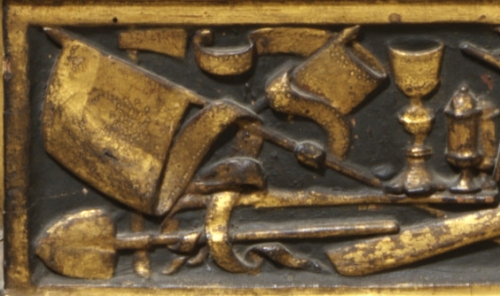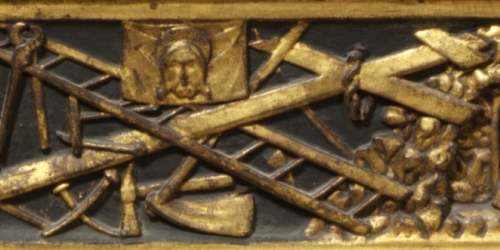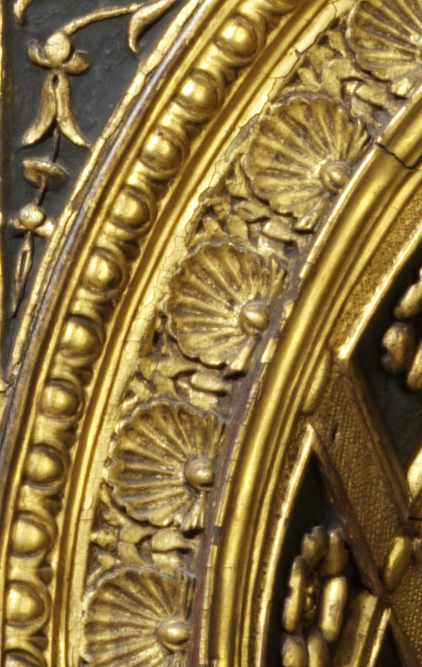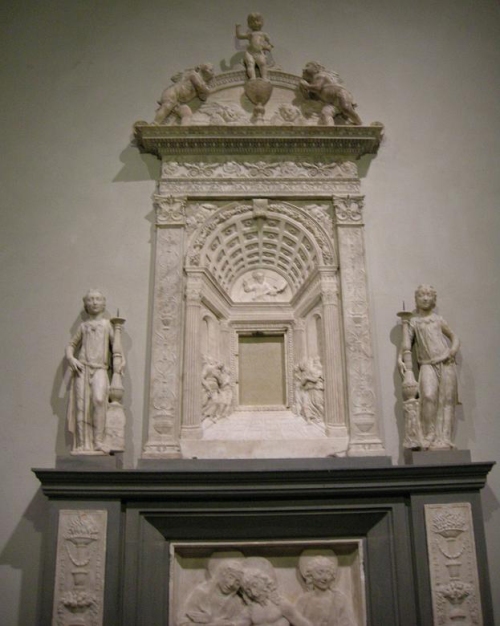Renaissance symbols: the iconography of a 15th century frame
by The Frame Blog
One of the most beautiful and interesting frames in London belongs to the V & A (although sadly it’s in storage at the moment). It’s a carved and gilded Renaissance aedicule, probably made in Tuscany[1] in the last quarter of the 15th century, and it was acquired by the Museum for £19 in 1859[2]. It’s quite an impressive size, standing 58 ½ inches high (148.5 cm), and is just over 40 inches across (102 cm), – although the part of the frame which is set back from the front portion (i.e. the outermost pilasters, with their attendant cornice and pedestals) may have been added later, perhaps to accommodate a change of position or a slightly different function.
 Carved aedicular frame, maker unknown, ?Tuscan, ?Venetian, 1475-1500, © Victoria and Albert Museum, London: museum no.: 5893-1859
Carved aedicular frame, maker unknown, ?Tuscan, ?Venetian, 1475-1500, © Victoria and Albert Museum, London: museum no.: 5893-1859
The structure and surface decoration of this frame have been intensively studied by Christine Powell and Zoë Allen, frame and woodwork conservators at the V & A, in their book, Italian Renaissance frames at the V & A, 2010, to which this article is indebted for all information as to its physical make-up; you can read much of the relevant entry on the Museum’s website. What is particularly interesting about this object, however, apart from its beauty, the skill of its execution and its pedigree, is the iconographic content of its decoration. This was clearly chosen very specifically by the clients who commissioned the frame, and was added to – also with great care – if and when the aedicule was enlarged. The main element in this respect is the predella panel, described as carved with the instruments of Christ’s Passion. This could be taken to mean the instruments of the Crucifixion, as on the ‘Medici’ frame of Veronese’s Holy Family, where the cherubs hovering in the folds of ornament hold nails, a hammer, pliers, a coil of rope, and a spear.
 Veronese, Holy Family with Sts Barbara & John the Baptist, 1550, Galleria degli Uffizi
Veronese, Holy Family with Sts Barbara & John the Baptist, 1550, Galleria degli Uffizi
The predella of the V & A frame is far more inclusive, however, comprising items and symbols which represent episodes from the last Supper onwards. The predella unrolls in a procession of objects from the centre outwards, with no chronological pattern in their placing but rather an emphasis on creating visual balance from this collection of disparate shapes, and a need to include everything relevant to the various events in Christ’s Passion.
Detail of predella: first section from left-hand side
So, starting from the far left, the objects in this section of the predella include two crossed banners scrolling around their shafts, a spade, an axe, a chalice and a small ciborium. The axe almost certainly refers to the cutting-down of a tree to make the cross; in apocryphal myths relating to the crucifixion, Christ’s cross was made from the wood of the tree of the knowledge of good & evil which grew in the Garden of Eden, and from which Adam and Eve had eaten fruit, precipitating the Fall.
Mosaic in the apse of the basilica of San Clemente, 1130s, Rome
See, for example, John Donne’s poem, ‘Hymn to God, my God, in my sickness’, 1623-35: ‘We think that Paradise and Calvary,/Christ’s cross, and Adam’s tree, stood in one place…’ This is often depicted, in paintings of the crucifixion, by setting the cross over a small cave-like tomb in which the skull of Adam is revealed; in the mosaic (above) the cross grows out of a bush in a new Eden.
The spade was presumably used to dig the hole to plant the cross, since Christ’s tomb was to be a ready-made cave in a rock, supposedly donated by Joseph of Arimathea. The chalice caught the blood of Christ, which flowed from His side; it also stands for the cup He used at the Last Supper, and through the latter represents the sacrament of the Eucharist: the changing of wine into the blood of Christ at Mass. The ciborium is the receptacle of the Host: the bread or body of Christ, taken during the Eucharist.
Agnus Dei or Lamb of God, stained glass, Church of St John the Baptist, Needham Market, Suffolk; photo by Simon Knott; see Simon’s Suffolk Churches
The banner is an accessory in representations of the risen Christ, who often carries one as He leaps from the tomb; the Lamb of Christ is also represented as carrying a banner. The framemaker seems to have conflated these two images, as the form engraved with star-shaped punches on the left-hand banner appears to be the face of a lamb.
Detail of predella: second section from left-hand side
The next section of the predella (reading from left to right) has a ladder forming a saltire with the cross, a pair of pliers, nails, a hammer, another axe (or a mattock), the crown of thorns twisted around the junction of the cross, and – in the centre of the saltire – a representation of St Veronica’s veil. These objects point towards events including the mocking of Christ, when he was given the crown of thorns, a purple mantle and a mock sceptre; see, for example, Mark 17: 17-20: ‘And they clothed him with purple and plaited a crown of thorns, and put it about his head. And began to salute him, Hail, King of the Jews!’ They are items which also record His progress through Jerusalem to His crucifixion – the Way of the Cross, or Via Crucis – during which St Veronica is said to have wiped his face with her veil, capturing on it a perfect image of Christ’s face. The other objects – ladder, cross, hammer, pliers, etc. – all relate to the crucifixion itself.
Detail of predella: first section from right-hand side
At the other end of the predella can be seen the lance of the centurion Longinus, with which he pierced Christ’s side, forming a diagonal cross with the forked stick holding a sponge, which was dipped in vinegar and given to Christ on the cross to drink.
Detail from the doors, 1015, Cathedral of St Mary, Hildesheim, Bernwardstür, Courtesy of Bischöfliche Pressestelle
Both actions can be seen in this relief of the crucifixion from the bronze doors of Hildesheim Cathedral.
A horizontal stave crosses this second saltire at the centre; it seems to be the shaft of a torch (the cage holding fire is at the extreme right edge). There is a curved horn or trumpet in the bottom right corner, the container for the vinegar at the junction of the crossed staves, and a representation of the Temple, in the shape of a falling censer, above it. To the left of these is the cat o’ nine tails, with which Christ was whipped, and at the left again another trumpet – this one with a swag of drapery, and probably belonging to a herald angel.
Detail of predella: second section from right-hand side
Moving in towards the centre from the right, the next section begins with a triangular form with clasp and tassel, set over another trumpet.
 Panel from an ivory casket, The Crucifixion of Christ, late Roman, AD 420-30, © Trustees of the British Museum
Panel from an ivory casket, The Crucifixion of Christ, late Roman, AD 420-30, © Trustees of the British Museum
This is Judas’s purse, containing the thirty pieces of silver; it often formed a detail of paintings of the Last Supper, and makes an appearance in conflated scenes of the crucifixion and Judas’s subsequent suicide – for instance, here, in an ivory in the British Museum. The purse can be seen beneath the feet of Judas, as he hangs from the tree at the left. Next along, the cockerel which crowed after Peter had denied Christ three times struts along the column to which Christ was tied to be whipped. Over the column hang Christ’s clothes, for which soldiers cast dice at the foot of the cross; a little pyramid of dice surmounts the clothes. Behind the column is the mock sceptre given to Christ, and – balanced near the top of the column – a covered jar. This is either the jar of ointment with which Mary Magdalene anointed the feet of the living Christ, or it represents the spices brought to the tomb by the women who were going to anoint His dead body. At the extreme lower left of this section, there is a curved knife, possibly standing for the sword which Peter used against one of the guards who came to arrest Christ.
Detail of predella: central section
Finally, the centre of the predella contains a carved representation of the rocky tomb, the stone half rolled away from the door. ‘…they came unto the sepulchre, bringing the spices which they had prepared, and certain others came with them. And they found the stone rolled away from the sepulchre…’ (Luke 24:1-2). Its position is important, as it signifies that the narrative displayed by the whole predella, from the Last Supper to the crucifixion, has moved beyond this, to the Resurrection of Christ: from death to the promise of life.
By the use of such objects, easily recognizable during the Renaissance by people of all classes, literate or not, the carver of the predella has set out the whole course of Christ’s Passion and Resurrection in a small space, and has also provided items to be meditated upon in prayer. If the actual narrative episodes had been used instead (as on most painted predellas), the effect would be like a graphic novel, where one pictorial frame illustrates one episode or part of a scene. As it is, this is more like a 17th century still life painting, in which the aesthetic arrangement of objects is used to help convey their meaning.
Candelabrum ornament & torch on left inner pilaster
The decoration of the rest of the frame above the predella contains further symbols, moving (literally) upwards into a more heavenly plane. For example, the candelabrum ornament on the two original pilasters bearing the arch terminates at each side in a flaming torch. This represents renewed life, Christ as the Light of the World, and the illumination of the soul.
Scallop shells from front of arch
The outer facade of the arch is lined with scallop shells, which are the emblem of the pilgrim, and the inner arch is carved with five cherubim (we know that they’re cherubim, because they have each have two pairs of wings). These are associated with the presence of God.
The question now arises, from all this symbolism loading the frame, what was it designed for? – where was the thrust of the symbols directing the worshipper? – what would the frame have contained?
One of the nearest forebears of this carved aedicule is a marble tabernacle by the master carver Desiderio da Settignano (c.1429-64).
Desiderio da Settignano, Tabernacle of the Sacrament, 1461, San Lorenzo, Florence
Desiderio was admitted to the guild of master carvers in stone and wood, the Arte dei maestri di pietra e legname, in June 1453, and opened a workshop with his brother near the Ponte Sta Trinità in Florence. Surprisingly soon afterwards he was employed on a major commission, the tomb of Carlo Marsuppini in Santa Croce, Florence (finished 1459)[3]. He was then commissioned, possibly by the Medici, to carve the tabernacle of the Sacrament in San Lorenzo. This held the sacred Host in a carved marble aedicule with the same trompe l’oeil perspective, inner arch, coffered ‘ceiling’ and floor with manipulated vanishing points, as the V & A frame. Desiderio’s work, however, was a large and complex structure, given greater form and presence by the altar of the Pietà on which it is raised, the two free-standing figures of angels which guard it, and the sculptural lunette above.
 Tabernacle of the Sacrament, central aedicule; carved aedicular frame, V & A
Tabernacle of the Sacrament, central aedicule; carved aedicular frame, V & A
It does not employ symbolism in the same way as the V & A frame; it is laden with figurative work – with angels, cherubim, Christ as a Child blessing on the crest of the lunette, Christ with the Bible in the tympanum at the back, the dead Christ on the façade of the altar – but otherwise it relies on purely decorative classicizing ornament for its effect. It was also designed specifically as a tabernacle to hold the sacrament, within a cupboard at the back, whereas the V & A frame has ‘no remnants of hinges or holes to indicate that there could have once been a door’[4].
The V & A frame, has, however, probably been altered at some unspecified point by the addition of the outer pilasters, with their attendant cornice and pedestals. If these were in fact part of the original conception, the function of the structure as some part of a sacramental container or cupboard might be more likely: possibly as a wall-mounted entrance to a niche within the church wall, which already possessed some means of being closed into a cupboard.
Outer pilaster with vines, detail; with dolphins, detail; carved aedicular frame, V & A
This may be possible, since the decoration of these outer pilasters is teeming with Eucharistic iconography. The candelabrum ornaments which rise from base to top are wreathed in vines bearing rather globular clusters of grapes: Christ is the vine, while the grapes stand for the wine of the Eucharist. Below the grapes two dolphins are posed on either side; again, the dolphin symbolizes Christ.
Outer pilaster with sun/moon & ears of wheat, detail; with cherubim, detail
Above the grapes, where the arch springs, what appears to be a flower with a face can be seen on each pilaster: these are actually traditional representations of the sun and the moon at the moment that Christ died on the Cross:
Sometimes, near to the top corners of the composition the sun and the moon are painted, in stylized form, each having human face, from which rays of light emanate… The two solar lights remind us both of universality and God’s creation and the two natures of Christ: his divine nature (the sun) and his human one (the moon)[5].
Ivory plaque with the Crucifixion between Mary and St John, the sun and moon carved in the upper corners, c.1130, German, © Trustees of the British Museum
The ears of wheat are another reference to the sacramental bread, and the cherubim signal the presence of God or Christ.
These various symbols, joined with the instruments of the Passion in the predella and with the flaming torches and cherubim, would certainly be appropriate to a tabernacle holding the Host. However, given that there is no evidence that the frame was ever used in this way, and considering the shape of the sight, with its slender elongated arch (compared with the small oblong ‘doorway’ of the San Lorenzo tabernacle), it seems much more likely that what the frame held was an image of the crucifixion, and that its symbolic programme was designed to support this and was later expanded in the same mode. The representations of sun and moon almost certainly confirm this idea.
Basilica of Sant’ Andrea in Mantua, Leon Alberti (begun in 1462)
The outer stages of the frame therefore make great sense in terms of their symbolic content. They also make great formal sense. The structure as a whole is evidently related to the San Lorenzo tabernacle, which was designed from the beginning with inner and outer pilasters[6]; it is also closely related to the Renaissance church in the form of a Roman triumphal arch. Looking, for instance, at the façade of Sant’ Andrea in Mantua, by Leon Alberti, the common ground between the V & A frame and contemporary architecture is strikingly clear. Even the insides of the arches have similar coffering. The addition of the outer pilasters has completed the frame as a formally perfect aedicule, in the same way that their decoration has completed its iconographical programme.
 Carved aedicular frame, maker unknown, ?Tuscan, ?Venetian, l475-1500, © Victoria and Albert Museum, London
Carved aedicular frame, maker unknown, ?Tuscan, ?Venetian, l475-1500, © Victoria and Albert Museum, London
The effect was designed to echo the vast and awe-inspiring entrance of a church like Sant’ Andrea both literally and metaphorically. The sloping floor of the niche was almost certainly inscribed or painted with receding perspectival lines, like those on the San Lorenzo tabernacle, intended to draw the worshipper in as if into the entrance of a majestic basilica – but this was a representation, not merely of a temporal church, but of the celestial Church, emphasized by the gilding and the decorative and symbolic ornament. The worshipper would approach, the perspective would welcome him or her spiritually into the niche (or nave of the church), and at the end a vision would appear, of the crucified Christ, with golden cherubim hovering above his head.
A final note on the colouring of the frame: the present dark navy ground, composed of French ultramarine, white and black, was applied in the 19th or early 20th century, possibly after the V& A acquired it[7]. The ground would originally have been painted a brighter and purer blue, over a warm base layer; the floor of the niche was probably marbled in red, and some of the carved objects in the predella seem to have been glazed over their gilding in transparent tones of red and purple. The original water gilding remains on the inner pilasters; elsewhere it has been over-gilded. The first colour scheme would have been much brighter, clearer and more varied. It would also have invoked the symbolic resonances of divine gold, celestial blue and blood-red: fitting for a crucifixion.
* All good wishes for a peaceful Easter from The Frame Blog *
I am very grateful to Zoë Allen and to the V & A for the opportunity to write about this frame; also to the British Museum, and to all the generous online donors of images noted above.
[1] Although see also Note 5 as to its region of manufacture.
[2] This doesn’t sound a huge amount, and translates in today’s prices to roughly £1,300, or $2,000, which isn’t excessive for such a rare and exquisite object; however; cost is not directly translatable between different eras for objects which would be differently valued in those eras. The average nominal earnings of a working person in 1859 were twice the cost of the frame (measuringworth.com), which would bring its price today to £52,000.
[3] See the biography of Desiderio da Settignano, National Gallery of Art, Washington. His work was extremely influential; see, for instance, wall-mounted sculptures by his colleague, Mino da Fiesole.
[4] C. Powell & Z. Allen, Italian Renaissance frames at the V & A, 2010, p.82
[5] Veronica Ion & Alexandina Păduretu, Religious Symbols in Christian Iconography, PhD thesis, 2010, p.4.
[6] The V & A frame has also been compared to a late 15th century Venetian aedicular frame illustrated, PL. XXXVI, in Guggenheim, Le cornici italiane dalla metà del secolo XV allo scorcio del XVI…, 1897. In this connection, it should be pointed out that the scallop shells round around the face of the arch are, as well as an emblem of the pilgrim, the attribute of Venice – on picture frames especially: these emphatically concave and sculptural shells, running in a continuous chain around a frieze or moulding appear on many Renaissance Venetian frames.
[7] C. Powell & Z. Allen, op. cit., p.81 ff.



















Simply fantastic!
LikeLike
Thank you… isn’t it?!
LikeLike
Another terrific and thoroughly researched post, Lynn. I hope you don’t mind I shared a link to it on our Gill & Lagodich Facebook page.
With warm regards, Tracy
https://www.facebook.com/pages/Gill-Lagodich-Gallery-Fine-Period-Frames-Restoration/163612427006400
LikeLike
Of course I don’t mind – I’m very pleased and flattered that you liked it enough to link to it, and thank you for such a nice comment!
V. best wishes,
Lynn
LikeLike
Now this is classy stuff girl ! It may sound odd but it’s lovely the way this knowledge of real things : the craft of knowing about craftsmanship. Happy Easter. Michael x
LikeLike
How nice of you to comment on this, Mike; art history can be like a detective story at times, which is partly why it’s constantly enthralling…
Happy Easter to you, too! x
LikeLike
An absolutely stunning post Lynn, and an highly intriguing frame – so wonderfully ornate that it is almost hard to image the painting that would have sat inside not being engulfed by it!
The wonderful illustrations offset your descriptions nicely – and it is fascinating to read that this unique piece is in storage.
I do have a question about the “banner of Christ” seen in one of the images – are there other examples of this to verify it is a banner denoting the resurrected Christ? It also appears quite similar to depictions of the “Vera Ikon” or “Veronica’s Veil” – from the apocrypha – of which Memling and Dürer provided some famous antecedent examples for. In this context it is perhaps more congruent to associate the veil with the Passion – and hence fits alongside the other images of the Crucifixion pictured in that part of the design?
Many kind regards
H
LikeLike
Thank you, Hasan – very kind of you, and I’m really glad that you enjoyed it.
I agree as to the frame being potentially overwhelming, although a lot of frames were very heavily ornamented – the Crivelli in the NG London, for instance; or (in a different way) the Doni Tondo. The V & A frame might possibly have held a marble relief, or – if it is indeed Venetian rather than Tuscan – a painted crucifixion with a gold ground, as these lingered much later in Venice. Either of these might have held its own better in the frame.
The banner is definitely connected with the risen Christ; I can’t think of a painting off-hand, but it is iconographically sound (He is often shown leaping semi-naked from the tomb, wrapped in a blue mantle, with the flag bearing a cross in one hand): I put the stained glass Lamb there instead because I was intrigued as to the lamb’s face on the banner. The flag in the predella definitely doesn’t have an image of Christ’s face, and also that appears clearly on the veil of St Veronica further along the predella. If you click on that link, it goes to Campin’s St Veronica.
So nice to have interesting questions! Thank you again for all your interest & appreciation…:)
LikeLike
Cheers for the clarification Lynn! A great example of a painting with the type of banner depicted on the left is Piero della Francesca’s famous “Resurrection” at Sansepolcro.
H
LikeLike
That’s exactly what I meant – thank you so much for looking it up for me and adding it here! I may do a link from the blog…
LikeLike